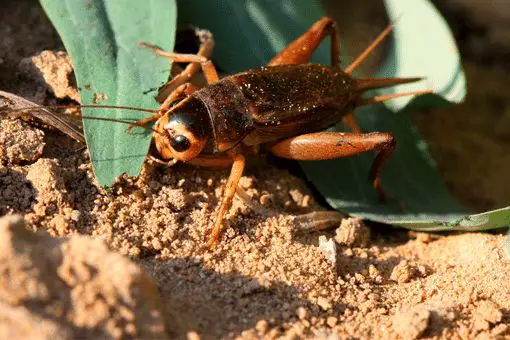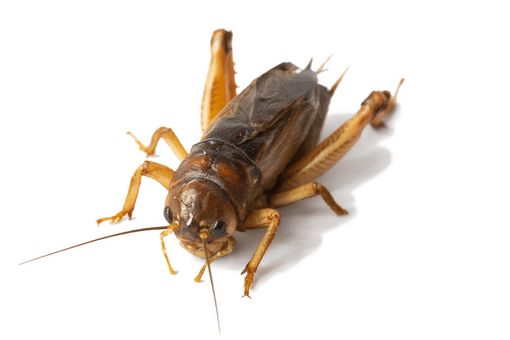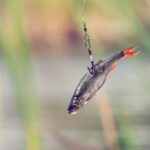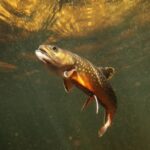Hungry fish love live bait. If fish could speak, they would tell you that live crickets are one of their favorites of all the fishing bait out there. If you are looking to fish with live bait, using a few crickets does not guarantee you will catch your limit, but it goes a long way toward getting you there.

Here is how to fish with crickets to catch just about any freshwater fish species that eat insects (almost all of them.)
Getting and Using Crickets
Getting your hands on some live crickets for fishing bait is easy, whether you buy them or catch them yourself.
Buying Crickets
If you search, you can find bait shops that sell crickets. Additionally, many pet stores do as well. You can also purchase crickets online through several outlets, including Amazon. The catch with any place you purchase crickets from will be the minimum quantity. Some pet stores let you buy as few as 10, but most require a minimum of a few dozen.
If you purchase more crickets than you can use in one fishing trip, you have a few options:
- Keep them alive by storing them in a cricket-friendly environment
- Freeze crickets for later use
- Grow a cricket colony
Keeping crickets alive requires a large bucket or bin. It is recommended to use a 14-gallon bin for a colony of 500 to 100. If you only use them for bait, a five-gallon bucket will work for the same amount of crickets. Regardless of what direction you take, make sure you follow these tips to keep your crickets in good shape:
- Give them access to water in a shallow dish that they will not drown in if they go into the dish
- Feed them with fruits like oranges and bread
- Keep their temperature consistent – 70 degrees Fahrenheit to the mid 90’s work best
- Keep their bin ventilated (a screen works best to allow ventilation and keep the crickets in the bin
- Provide them with bedding and shelter material (vermiculite works well)
Catching Crickets
Because they are terrestrial insects, catching crickets is another option, and if you are fishing with kids, probably the most fun. When in season, you can find crickets in shrubs, under plant leaves or boards lying on grass and along foundations of buildings, but your best bet is to target taller grass.

Their chirping is a giveaway that you are in the vicinity of at least one cricket. Look for covered spots that let the cricket hide from predators, such as under leaves, buckets, etc.
To catch them, you can chase them with an insect net or chase them down by hand. The key to either method is to handle a cricket gently enough to avoid injury but firmly enough to catch them. In a cricket-ripe environment, an hour’s searching and chasing can yield more crickets than you use in one fishing trip.
Another option to catch crickets is to lure them via a trap. One method is lay a flat cardboard panel on the ground and leave it out overnight. Check underneath the panel in the morning. Your chances are very good you will find a few crickets. You can scoop them up with a net, but you need to be fast as crickets are surprisingly quick when trying to flee a predator.
Crickets also like to eat wheat and you can use that to trap them. Buy an uncut loaf of bread and hollow out one end through to about halfway into the loaf, creating a tunnel. Leave the bread out overnight and in the morning, shake the loaf over a bucket and you should have several crickets that fall out.
Hooking Crickets
There are a few ways to hook crickets, and watching a video or two online is not a bad idea. The easiest way is to hook them through their belly, hook up, and facing backward. Hooking through the belly lets the cricket move without restriction. The tradeoff is that they will die quicker, so you will be swapping out your bait more often.
Some people like to run a long shank cricket hook up through their back, which anchors the hook more effectively in the cricket, halting the ability of fish to jab at and break it apart. You can do this one of two ways:
Run the hook just below the base of the cricket’s head and down the protective shell on its back like you would rig a plastic bait. Or, use the shank and eye of the hook and run them up underneath the same shell, starting at their backside and working up. The downside to this method, while it does ensure your cricket stays on your hook, is that they die a lot quicker.
Species You Can Catch While Fishing With Crickets
Just about any hungry fish species will go after a cricket if the presentation and environment are right. Crickets are a natural food source for your smaller predator fish, but even larger fish will go after a cricket if the water temperature has them in feeding mode.
- Bluegill: A larger panfish, bluegill will go after medium to small crickets in almost any water temperature, including while ice fishing.
- Sunfish: If you want to learn how to fish with crickets, targeting sunfish is your best bet because the fish view them as a delicacy.
- Bass: If the temperature is right, bass will eat just about everything, and you will be amazed at the size of some of the bass that will go after a cricket.
- Bream: Bream fishing using bait crickets live is almost a sure thing as crickets are one of a bream’s go-to food sources.
- Yellow Perch: Yellow perch are like bass in that if they are in feeding mode, they will go after anything, and they love live crickets.
- Crappie: Like bass and yellow perch, crappie will go after any live cricket.
- Trout: Crickets will catch trout if presented properly. Brown trout will go after any cricket bait, but for rainbow trout or cutthroat trout, your best bet is to use bait crickets live.
How To Fish With Crickets
Fishing for crickets is easy if you tailor your kit for the type of fish you are targeting.
Have a Suitable Rig Setup
If you are learning how to fish with crickets, your best bet is to use a traditional bobber and hook rig. For the more experienced angler, using a drop-shot rig is an option, as is going weightless, which works well in bodies of water with a current.
A #8 long shank hook works best (also called a “cricket” hook by some manufacturers. If you do bait crickets with a #8 long shank, ensure you pierce them through the body, hook point facing their rear to keep them alive longer and give them suitable mobility.
Choose Your Rod Carefully
Your rod type should be determined by the fish species you are targeting. If you are fishing for yellow perch, for example, you want a light rod that is sensitive but will still allow you to easily land a larger fish. The same logic applies to bass, trout, crappie, and bluegill. If the fish in your area tend to be on the larger side, a faster-action medium rod will also work.
For smaller fish, like sunfish, you want an ultra-light. Using a rod like that will let you feel when a sunfish has taken your bait, making the fish seem much larger than it is. Using heavier rods on sunfish makes it more difficult to detect a bite, and bringing them in is a lot less fun.
Your reel should also reflect your rod choice. Use a smaller reel with a lighter rod, as it balances the rod better and makes bringing in smaller fish go more smoothly. Also, you should use lighter line. A four to six-pound test line is ideal. Any heavier and you lose sensitivity, which you need with smaller baits and smaller fish.
Take Advantage of Spawn Season
Targeting fish with crickets during the spawning season is a great strategy. The crickets provide a moving target for fish that are both hungry and dedicated to protecting their nest. If you live in a colder region of the country, crickets might not be prevalent in late spring when fish spawn, so your best option is to buy them.
If you use crickets to target fish during their spawning period, you will want to use a very small bobber. During this period, fish are very suspect of any bait, and getting a reaction strike is your best bet. The fish might stay put with a bobber hovering over their nesting area and creating a shadow on the bottom.
Use a Cricket Keeper
You can get several products at a department store for holding bait, including cricket holders. Another option is to keep them in a five-gallon bucket with a screen for a lid.

Stay Mobile
The most enticing cricket is one that is flailing about the water, making it look like it fell in and is a helpless target. You should change your bait whenever you notice the cricket has stopped moving.
Freezing Crickets for Bait
Follow these instructions for freezing crickets.
- Give your crickets ample food and water, and let them live for two days.
- Tape up your container and put it in the freezer for an hour.
- Move your crickets into plastic bags once they are frozen, and store them in your freezer.
When you are using them for bait, let them thaw briefly, but not entirely, before you impale them on your hook.
Frequently Asked Questions
The following are frequently asked questions anglers have about how to fish with crickets.
Can you hook a cricket without having to pierce it?
You can tie crickets onto the hook, but the downside is that you have to tie them so tightly that you will injure them or make them immobile, or else they can escape fairly easily.
When is the best time to use crickets as bait?
Using crickets as bait will work all year long but works best in mid to late summer and is least effective late fall through early spring.
How long do crickets live?
Crickets live on average for about 90 days, which provides you a window of the entire summer if you buy a bunch in mid-June.
What are good alternatives to crickets?
Multiple plastic baits provide cricket-like movement, and a few hard baits mimic crickets. You also have live worms that work just as well in the right environment.
Final Thoughts
Hungry fish view live crickets as an easy meal. If you tailor your rig to the type of fish you are going after and use one of the methods above, it is difficult to avoid a fish going after a cricket. Your most important tip for using crickets as bait effectively is to swap them out once they stop moving, as moving crickets are irresistible to fish.
- Do You Need An Indicator For Nymph Fishing? - November 16, 2023
- Fishing Safety Tips For Families - September 25, 2023
- What Is The Best Time To Night Fish At A Lake? - September 18, 2023










